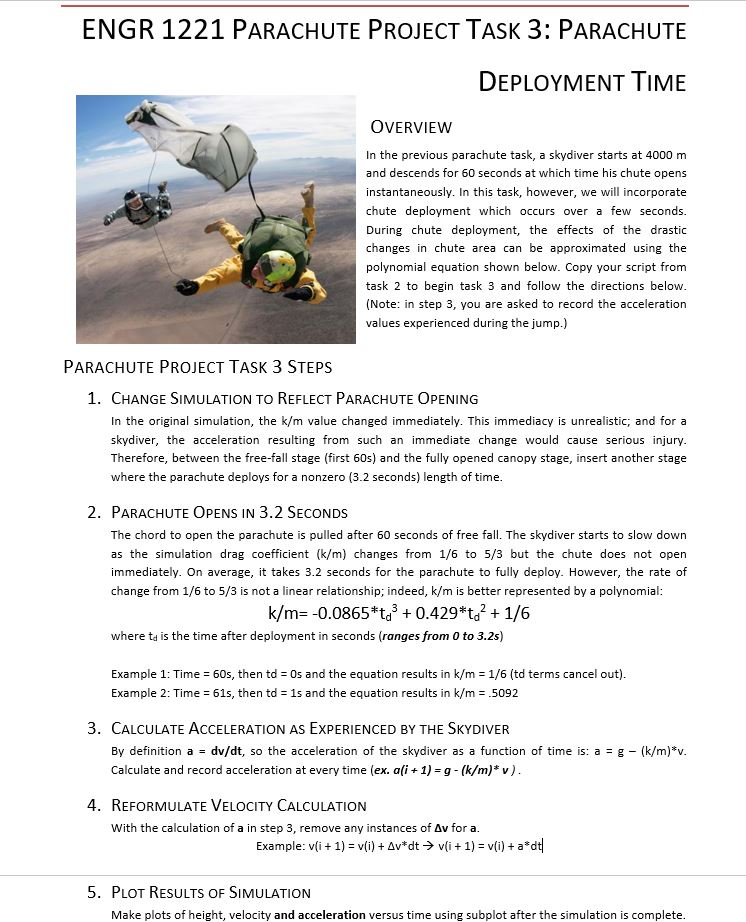Question
OVERVIEW In the previous parachute task, a skydiver starts at 4000 m and descends for 60 seconds at which time his chute opens instantaneously. In
OVERVIEW In the previous parachute task, a skydiver starts at 4000 m and descends for 60 seconds at which time his chute opens instantaneously. In this task, however, we will incorporate chute deployment which occurs over a few seconds. During chute deployment, the effects of the drastic changes in chute area can be approximated using the polynomial equation shown below.

Here is my task 2 code
%Task 2
h=4000;%initial height dt=0.1;%time step g=9.81;%acceleration due to gravity
t=0;%inital time v=0;%inital velocity
n=1; while h>0 if t
tt=dt*(1:n-1);
figure(); ax3 = subplot(2,1,1); plot(ax3,tt,vf) xlabel('Time(s)') ylabel('Velocity(m/s)') title('Time vs Velocity')
ax4 = subplot(2,1,2); plot(ax4,tt,hf) xlabel('Time(s)') title('Time vs Height') ylabel('Height(m)')
ENGR 1221 PARACHUTE PROJECT TASK 3: PARACHUTE DEPLOYMENT TIME OVERVIEW In the previous parachute task, a skydiver starts at 4000 m and descends for 60 seconds at which time his chute opens instantaneously. In this task, however, we will incorporate chute deployment which occurs over a few seconds. During chute deployment, the effects of the drastic changes in chute area can be approximated using the polynomial equation shown below. Copy your script from task 2 to begin task 3 and follow the directions below (Note: in step 3, you are asked to record the acceleration values experienced during the jump.) PARACHUTE PROJECT TASK 3 STEPS 1. CHANGE SIMULATION TO REFLECT PARACHUTE OPENING In the original simulation, the k/m value changed immediately. This immediacy is unrealistic; and for a skydiver, the acceleration resulting from such an immediate change would cause serious injury Therefore, between the free-fall stage (first 60s) and the fully opened canopy stage, insert another stage where the parachute deploys for a nonzero (3.2 seconds) length of time 2. PARACHUTE OPENS IN 3.2 SECONDS The chord to open the parachute is pulled after 60 seconds of free fall. The skydiver starts to slow down as the simulation drag coefficient (k/m) changes from 1/6 to 5/3 but the chute does not open immediately. On average, it takes 3.2 seconds for the parachute to fully deploy. However, the rate of change from 1/6 to 5/3 is not a linear relationship; indeed, k/m is better represented by a polynomial k/m0.0865*td30.429*td 1/6 where td is the time after deployment in seconds (ranges from 0 to 3.2s) Example 1: Time = 60s, then td = 0s and the equation results in k/m = 1/6/td terms cancel out) Example 2: Time = 61s, then td = 1s and the equation results in k/m .5092 3. CALCULATE AcCELERATION AS ExPERIENCED BY THE SKYDIVER By definition a = dv/dt, so the acceleration of the skydiver as a function of time is: a = g-(k/m)*v Calculate and record acceleration at every time (ex, a(i + 1) = g-(k/m)* v) 4. REFORMULATE VELOCITY CALCULATION With the calculation of a in step 3, remove any instances of Av for a Example: v(i + 1)-v(i) + Av*dt v(i + 1) = v(i) + a*d 5. PLOT RESULTS OF SIMULATION Make plots of height, velocity and acceleration versus time using subplot after the simulation is complete ENGR 1221 PARACHUTE PROJECT TASK 3: PARACHUTE DEPLOYMENT TIME OVERVIEW In the previous parachute task, a skydiver starts at 4000 m and descends for 60 seconds at which time his chute opens instantaneously. In this task, however, we will incorporate chute deployment which occurs over a few seconds. During chute deployment, the effects of the drastic changes in chute area can be approximated using the polynomial equation shown below. Copy your script from task 2 to begin task 3 and follow the directions below (Note: in step 3, you are asked to record the acceleration values experienced during the jump.) PARACHUTE PROJECT TASK 3 STEPS 1. CHANGE SIMULATION TO REFLECT PARACHUTE OPENING In the original simulation, the k/m value changed immediately. This immediacy is unrealistic; and for a skydiver, the acceleration resulting from such an immediate change would cause serious injury Therefore, between the free-fall stage (first 60s) and the fully opened canopy stage, insert another stage where the parachute deploys for a nonzero (3.2 seconds) length of time 2. PARACHUTE OPENS IN 3.2 SECONDS The chord to open the parachute is pulled after 60 seconds of free fall. The skydiver starts to slow down as the simulation drag coefficient (k/m) changes from 1/6 to 5/3 but the chute does not open immediately. On average, it takes 3.2 seconds for the parachute to fully deploy. However, the rate of change from 1/6 to 5/3 is not a linear relationship; indeed, k/m is better represented by a polynomial k/m0.0865*td30.429*td 1/6 where td is the time after deployment in seconds (ranges from 0 to 3.2s) Example 1: Time = 60s, then td = 0s and the equation results in k/m = 1/6/td terms cancel out) Example 2: Time = 61s, then td = 1s and the equation results in k/m .5092 3. CALCULATE AcCELERATION AS ExPERIENCED BY THE SKYDIVER By definition a = dv/dt, so the acceleration of the skydiver as a function of time is: a = g-(k/m)*v Calculate and record acceleration at every time (ex, a(i + 1) = g-(k/m)* v) 4. REFORMULATE VELOCITY CALCULATION With the calculation of a in step 3, remove any instances of Av for a Example: v(i + 1)-v(i) + Av*dt v(i + 1) = v(i) + a*d 5. PLOT RESULTS OF SIMULATION Make plots of height, velocity and acceleration versus time using subplot after the simulation is completeStep by Step Solution
There are 3 Steps involved in it
Step: 1

Get Instant Access to Expert-Tailored Solutions
See step-by-step solutions with expert insights and AI powered tools for academic success
Step: 2

Step: 3

Ace Your Homework with AI
Get the answers you need in no time with our AI-driven, step-by-step assistance
Get Started


